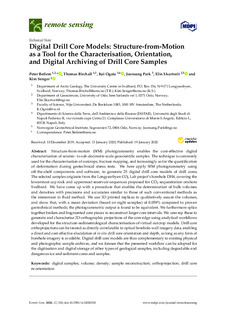Digital Drill Core Models: Structure-from-Motion as a Tool for the Characterisation, Orientation, and Digital Archiving of Drill Core Samples
Peer reviewed, Journal article
Published version
Permanent lenke
http://hdl.handle.net/11250/2637931Utgivelsesdato
2020Metadata
Vis full innførselSamlinger
- NGI articles [1061]
Sammendrag
Structure-from-motion (SfM) photogrammetry enables the cost-effective digital characterisation of seismic- to sub-decimetre-scale geoscientific samples. The technique is commonly used for the characterisation of outcrops, fracture mapping, and increasingly so for the quantification of deformation during geotechnical stress tests. We here apply SfM photogrammetry using off-the-shelf components and software, to generate 25 digital drill core models of drill cores. The selected samples originate from the Longyearbyen CO2 Lab project’s borehole DH4, covering the lowermost cap rock and uppermost reservoir sequences proposed for CO2 sequestration onshore Svalbard. We have come up with a procedure that enables the determination of bulk volumes and densities with precisions and accuracies similar to those of such conventional methods as the immersion in fluid method. We use 3D printed replicas to qualitatively assure the volumes, and show that, with a mean deviation (based on eight samples) of 0.059% compared to proven geotechnical methods, the photogrammetric output is found to be equivalent. We furthermore splice together broken and fragmented core pieces to reconstruct larger core intervals. We unwrap these to generate and characterise 2D orthographic projections of the core edge using analytical workflows developed for the structure-sedimentological characterisation of virtual outcrop models. Drill core orthoprojections can be treated as directly correlatable to optical borehole-wall imagery data, enabling a direct and cost-effective elucidation of in situ drill core orientation and depth, as long as any form of borehole imagery is available. Digital drill core models are thus complementary to existing physical and photographic sample archives, and we foresee that the presented workflow can be adopted for the digitisation and digital storage of other types of geological samples, including degradable and dangerous ice and sediment cores and samples.
